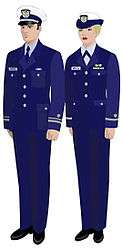Uniforms of the United States Coast Guard Auxiliary
The uniforms of the United States Coast Guard Auxiliary serve to distinguish Auxiliarists from members of other civilian auxiliaries and of other armed services. Auxiliarists are expected to wear a uniform intended for the situation and mission.[1] Each auxiliary uniform is identical to a Coast Guard officer's military uniform, with the exception that the buttons and stripes on dress jackets and shoulder boards are silver in color, rather than gold. On dress uniforms, appointed staff officers wear insignia with a red "A" and elected officers wear insignia with a blue "A", while black "A"s are worn on insignia by both elected and appointed officers on the ODU uniform. Auxiliarists are expected to adhere to the same rules of correct uniform wear as regular Coast Guard officers. When augmenting Coast Guard personnel, the military-style insignia of Auxiliary position is generally removed and the organizational insignia is worn.
Rank insignia and awards

While Auxiliarists wear military style rank insignia to signify office or position, they do not use military titles.[2] For example, a Flotilla Commander wears insignia similar to a USCG lieutenant, but is never referred to as "Lieutenant." The title most commonly used in official correspondence and reports is "Auxiliarist", and its abbreviation (e.g., Auxiliarist John Smith or AUX J. Smith).[2] Exceptions to this rule are elected or appointed Commodores, who wear one to three stars depending on their office, and are the only Auxiliarists who use a military style title ("Commodore") and its abbreviation before their name (e.g., Commodore Jane Jones or COMO J. Jones).[2]
Auxiliarists may be awarded medals and decorations of the Coast Guard or Coast Guard Auxiliary, and may wear medals and decorations awarded in prior military service.[2] The wear of prior military service awards is different from active and reserve Coast Guardsmen, as they can wear only awards earned while in the Coast Guard and serving with other branches.
A 2006 issue of the Reservist magazine was devoted to a detailed and easy to understand graphical description of all the authorized uniforms.
Dress uniforms
Prior to 1972, all Coast Guard personnel wore the same uniforms as the U.S. Navy uniform with distinctive Coast Guard insignia, primarily cap devices for officers, chief petty officers, and Auxiliarists; incorporation of the Coast Guard shield in lieu of line or staff corps insignia for officers, and differentiated uniform buttons on dress uniforms.
In 1972, the current Coast Guard Dress Blue uniform was introduced for wear by officers, enlisted personnel, and Auxiliarists; the transition was completed during 1974. Relatively similar in appearance to the old-style U.S. Air Force uniforms, the uniform consists of a blue four-pocket single breasted jacket and trousers in a slightly darker shade. A light-blue button-up shirt with a pointed collar, two front button-flap pockets and enhanced shoulder boards is worn when in shirt-sleeve order (known as Tropical Blue). It is similar to the World War II-era uniforms worn by Coast Guard Surfmen. Unlike the U.S. Navy, members of the Coast Guard do not wear khaki; all personnel wear the same color uniform. See USCG Uniform Regulations for current regulations.
Auxiliarists also have a Dress White uniform, nearly identical to the "choker white" uniform worn by naval officers (aside from Auxiliary-specific insignia), typically used for formal parade and change-of-command ceremonies. For similar occasions, Auxiliarist may also wear either Service Dress Blue or Full Dress Blue. Full Dress Blue replaces the light blue shirt with a white shirt, and miniature medals are worn on the jacket. A white belt may be worn for honor guards. Mess dress uniforms are worn by members for formal (black tie) evening ceremonies; like the dress white officer uniform, the mess dress uniforms are identical to those of the U.S. Navy, aside from Coast Guard-specific insignia.
All Coast Guard members wear the combination cap with all dress and service uniforms. A garrison cap may be optionally worn with the Tropical Blue and Winter Dress Blue uniforms.
Service dress uniforms
 Service Dress Blue
Service Dress Blue Service Dress White
Service Dress White
Undress uniforms
 Winter Undress Blue
Winter Undress Blue Winter Dress Blue
Winter Dress Blue Tropical Blue
Tropical Blue
Dinner dress uniforms
 Dinner Dress Blue Jacket
Dinner Dress Blue Jacket Dinner Dress White Jacket
Dinner Dress White Jacket Dinner Dress Blue
Dinner Dress Blue Dinner Dress White
Dinner Dress White
Undress and working uniforms
The current working uniform of a majority of Auxiliarists is the Operational Dress Uniform (ODU). The ODU is similar to the Battle Dress Uniform of other armed services, both in function and style. However, the ODU is in a solid dark blue with no camouflage patterns and does not have lower pockets on the blouse. The ODU is worn with composite toe boots in most circumstances, but low-cut black or brown boat shoes may be prescribed for certain situations. The former dark blue working uniform has been withdrawn from use by the Coast Guard but may be worn by Auxiliarists until December 31 2012. In the fall of 2008 a second generation Operational Dress Uniform was introduced. It resembles the current Battle Dress blouse, which is worn on the outside, rather than tucked in. In addition it has a black Coast Guard insignia embroidered on the left shirt pocket as well as the side pockets of the trousers. This next generation ODU is an optional uniform item, the older style "tucked" ODU may be worn until no longer servicable. A baseball-style cover is worn with the ODU uniform, embroidered in silver block lettering with "U.S. Coast Guard Auxiliary".
Several "Undress Blue" uniforms were phased out at the end of 2012, the only one retained was "Winter Undress Blue".
 ODU Untucked
ODU Untucked Flight Suit[3]
Flight Suit[3]
Notes
References
External links
| Wikimedia Commons has media related to USCGAUX Uniforms. |
